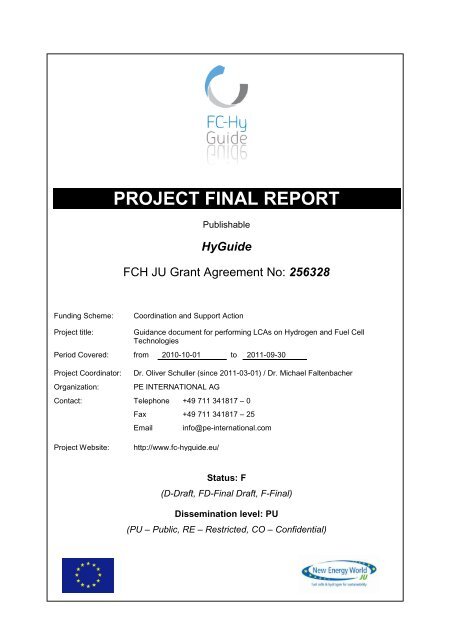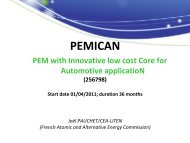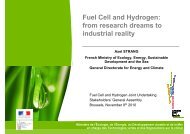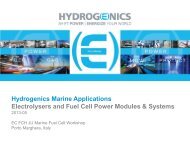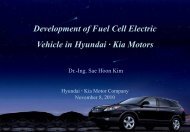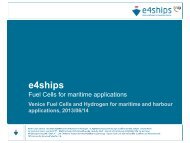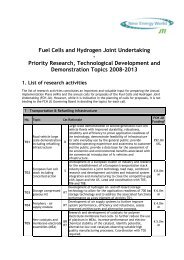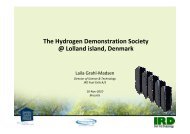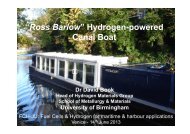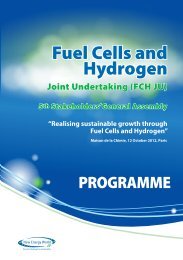Project final report publishable summary - FCH JU
Project final report publishable summary - FCH JU
Project final report publishable summary - FCH JU
Create successful ePaper yourself
Turn your PDF publications into a flip-book with our unique Google optimized e-Paper software.
PROJECT FINAL REPORT<br />
Publishable<br />
HyGuide<br />
<strong>FCH</strong> <strong>JU</strong> Grant Agreement No: 256328<br />
Funding Scheme: Coordination and Support Action<br />
<strong>Project</strong> title: Guidance document for performing LCAs on Hydrogen and Fuel Cell<br />
Technologies<br />
Period Covered: from 2010-10-01 to 2011-09-30<br />
<strong>Project</strong> Coordinator: Dr. Oliver Schuller (since 2011-03-01) / Dr. Michael Faltenbacher<br />
Organization: PE INTERNATIONAL AG<br />
Contact: Telephone +49 711 341817 – 0<br />
Fax +49 711 341817 – 25<br />
Email info@pe-international.com<br />
<strong>Project</strong> Website: http://www.fc-hyguide.eu/<br />
Status: F<br />
(D-Draft, FD-Final Draft, F-Final)<br />
Dissemination level: PU<br />
(PU – Public, RE – Restricted, CO – Confidential)
Publishable <strong>summary</strong> <strong>report</strong><br />
<strong>Project</strong> Final Report – Publishable<br />
FC-HyGuide includes two autonomous projects and consortia: HyGuide and FC-Guide.<br />
While FC-Guide focuses on fuel cell technologies HyGuide addresses hydrogen production<br />
systems.<br />
HyGuide<br />
(lead by PE)<br />
FC-HyGuide<br />
FC-Guide<br />
(lead by ENEA)<br />
“Hydrogen supply technologies” “Fuel Cell technologies”<br />
Figure Fehler! Kein Text mit angegebener Formatvorlage im Dokument.-1 - FC-HyGuide<br />
– Consortia structure<br />
The two consortia, led by PE INTERNATIONAL resp. ENEA agreed during the project<br />
negotiation phase to collaborate closely. The collaboration included a common work<br />
programme, interlinked work packages, and common choices on key overall LCA<br />
methodological topics. The advisory board / review panel and the technical expert group<br />
were also shared by both consortia. The reason for the collaboration between the two<br />
consortia was to produce more value for the <strong>FCH</strong> <strong>JU</strong> funding and to avoid contradictory<br />
results. For that reason, the only public domain used, is FC-HyGuide.<br />
The overall goal of the call “SP1-JTI-<strong>FCH</strong>.2009.5.5 LIFE CYCLE ASSESSMENT (LCA)” is to<br />
develop a specific guidance document(s) for application to hydrogen and fuel cell<br />
technologies and related training material with courses for practitioners in industry and<br />
research. These documents (one on hydrogen supply technologies, one on fuel cells) are<br />
based on and in line with the International Reference Life Cycle Data System (ILCD)<br />
Handbook, coordinated by the European Commission's JRC-IES.<br />
In other words, the main objective of the FC-HyGuide project in the 12 months is the<br />
development of guidance documents and accompanying LCA <strong>report</strong> templates to evaluate<br />
the environmental benefits of new technologies in the field of fuel cell and hydrogen<br />
applications.<br />
It is foreseen that the guidance documents developed within FC-HyGuide will be applied in<br />
all on-going and future <strong>FCH</strong> <strong>JU</strong> projects calling for Life Cycle Assessment (LCA).<br />
The concept of the project is related to the international standardised procedure<br />
Environmental Product Declaration (EPD) System (ISO 14025), providing consistent<br />
information using common program and product category rules (PCR). The developed<br />
guidance documents (HyGuide and FC-Guide) are similar to a PCR document.<br />
The guidance documents were developed in a multi stage stakeholder approach. In the first<br />
stage a draft version of the guidance documents were developed by the project consortia<br />
and introduced to the technical expert group of the project. Feedback gained during the<br />
expert group workshop was integrated and advanced versions of the guidance documents<br />
were prepared. In the following stage they passed a second consultation round. This<br />
consultation was public. Before the documents were <strong>final</strong>ly released, an independent<br />
Grant agreement no. 2/5 25.11.2011<br />
256328
<strong>Project</strong> Final Report – Publishable<br />
external third party review process was performed to ensure the quality of the documents.<br />
Dissemination and communication were core elements and performed during the whole<br />
project period. Two training courses on the developed guidance documents completed the<br />
project. A graphical overview of the concept of stakeholder involvement within FC-HyGuide is<br />
given in the following graph.<br />
Preparation, consultation and review of the<br />
guidance document<br />
Preparation and consultation<br />
of the guidance document<br />
Review and <strong>final</strong>isation<br />
of the guidance document<br />
Dissemination, external communication<br />
and training courses<br />
Workflow, connected tasks and work packages<br />
Input by project organs<br />
comments<br />
comments<br />
comments<br />
Figure Fehler! Kein Text mit angegebener Formatvorlage im Dokument.-2: Major components of<br />
FC-HyGuide<br />
Considering the main objectives of the project, a detailed strategy was developed to assure<br />
their achievement in a structured and manageable way. In that regard, the project was<br />
structured in five work packages (excluding project management). Due to their inherent<br />
complexity, some of the work packages (WP) were structured in to different tasks.<br />
WP1 – Development, design, implementation and usage of a website: A project website<br />
was developed in which all project related information and materials can be found, see<br />
http://www.fc-hyguide.eu/. The website acts as fully integrated platform of the ILCD data<br />
network. The tasks were:<br />
Task 1.1: Development of the website. The website is part of the ILCD data network,<br />
i.e. it is also the platform for storing life cycle data sets on hydrogen and fuel cells<br />
which will be developed in on-going <strong>FCH</strong> <strong>JU</strong> projects;<br />
Task 1.2: Content provision: This task comprised the provision of content on the<br />
webpage, such as a general project description<br />
WP2 – Development of the structure and content of the guidance document, including<br />
key methodology aspects: Within this WP, a project kick-off meeting took place. This<br />
meeting was an important step for the share of knowledge among the partners of both<br />
Grant agreement no. 3/5 25.11.2011<br />
256328<br />
Technical Expert Group<br />
<strong>Project</strong> consortium<br />
Advisory Board / Review Panel<br />
<strong>Project</strong> council<br />
Public<br />
Public
<strong>Project</strong> Final Report – Publishable<br />
consortia, allowing the development of the draft guidance document, as well as the drafts<br />
for the LCA study <strong>report</strong>ing templates.<br />
WP3 – Preparation and consultation of the guidance documents: This WP was divided<br />
into five tasks.<br />
Task 3.1: A workshop was organised to introduce the draft guidance document to the<br />
technical expert group and discuss it. The workshop was facilitated by an<br />
professional moderator.<br />
After the workshop, the draft guidance document was published on the project<br />
website, in the restricted area, where the members of the technical expert group (and<br />
advisory board / review panel) were able to review it and post their comments.<br />
Therefore, the members of the technical expert group had the opportunity to provide<br />
their feedback both on the workshop and on the website.<br />
Task 3.2: A revised version of the guidance document was prepared after the<br />
workshop. The revised (advanced) version included the feedback from the workshop<br />
as well as the feedback received in the consultation timeframe after the workshop.<br />
The advanced guidance and a “comments & reply” document (compilation document<br />
with the cumulative feedback from the consultation round) were published at the<br />
restricted area of website.<br />
Task 3.3: In this second consultation round, the technical expert group, the advisory<br />
board / technical expert group, and the public were able to comment on the document<br />
within a timeframe of six weeks. The main goal of the second consultation round was<br />
to validate the advanced guidance document, by investigating appropriateness,<br />
completeness, and usability. The feedback of the second consultation round was<br />
used to refine the guidance document.<br />
Task 3.4: The draft of the <strong>final</strong> guidance document, based on the received comments<br />
– together with the comments & reply document – was prepared and published on the<br />
website.<br />
Task 3.5: Before the <strong>final</strong> release, the review panel (independent group of experts)<br />
approved the documents. The <strong>final</strong>isation step was of an iterative nature and in the<br />
end a <strong>final</strong> guidance document and a review <strong>report</strong> were published.<br />
WP4 – Case studies: The applicability of the guidance document was demonstrated by<br />
conducting case studies, i.e. LCAs of a hydrogen production and fuel cells technologies<br />
were conducted and the resulting data set are published on the website, as part of the<br />
ILCD data network. The experience gained by conducting the case studies was<br />
integrated into the guidance document. Therefore, the WP4 was strongly linked to WP3.<br />
WP5 – Dissemination, external communication, and training courses: The outcomes from<br />
WP3 and WP4 were directly used for application in workshops, training courses etc. As<br />
awareness, dissemination and usefulness are essential aspects to meet the <strong>FCH</strong> <strong>JU</strong><br />
goals, special attention was given to the transfer of knowledge to industry and research<br />
members, on how to conduct LCA using the guidance documents. The training materials<br />
were revised and amended by the feedback gained during the two training courses in an<br />
iterative procedure to maximize their quality. The training materials are also available at<br />
http://www.fc-hyguide.eu/.<br />
The applied concept and work programme were developed considering the following key<br />
objectives, defined by the <strong>FCH</strong> <strong>JU</strong>:<br />
Enabling the market breakthrough of fuel cell and hydrogen technologies and placing<br />
Europe as a leader in these technologies;<br />
Supporting RTD in member states and associated countries in a coordinated manner<br />
in order to avoid market failure, focus on developing market applications and facilitate<br />
a rapid development of fuel cells and hydrogen technologies;<br />
Grant agreement no. 4/5 25.11.2011<br />
256328
<strong>Project</strong> Final Report – Publishable<br />
Supporting the implementation of RTD priorities of the multi-annual-implementation<br />
plan of the <strong>FCH</strong> <strong>JU</strong>;<br />
Encouraging increased public and private investment in fuel cell and hydrogen<br />
technologies;<br />
Ensuring the coordination and efficient management of funds. Supporting the<br />
principles of transparency and openness, competitiveness and excellence,<br />
inclusiveness and close cooperation among stakeholders in order to achieve the best<br />
possible benefit.<br />
The main outcome of the project are two guidance documents on “how to perform Life Cycle<br />
Assessment (LCA) in the field of hydrogen production and fuel cell technologies”. These<br />
documents were developed in a peer reviewed stakeholder process (incl. public consultation)<br />
and are available (ready-to-use) for on-going <strong>FCH</strong> <strong>JU</strong> projects. The platform, as an<br />
integrative part of the ILCD data network, can be used as a hub for LCA data sets in the field<br />
of hydrogen and fuel cells.<br />
For further information please visit http://www.fc-hyguide.eu/ or contact the coordinators via<br />
email info@fc-hyguide.eu.<br />
List of Beneficiaries<br />
Beneficiary name Contact Name Associated Coordinates<br />
PE INTERNATIONAL AG Dr. Oliver Schuller PE INT<br />
Universitaet Stuttgart, Chair for<br />
Building Physics, Department Life<br />
Cycle Engineering (LBP-GaBi)<br />
Karlsruhe Institute of Technology<br />
(KIT), Institute of Applied Computer<br />
Science (IAI)<br />
European Hydrogen Association<br />
(EHA) represented by The Italian<br />
Federation of Scientific and<br />
Technical Associations (FAST)<br />
European Commission represented<br />
by the European Commission -<br />
Directorate General Joint Research<br />
Centre JRC-IE<br />
Website: http://www.fc-hyguide.eu/<br />
Contact: info@fc-hyguide.eu<br />
Aleksandar Lozanovski USTUTT<br />
Dr. Clemens Düpmeier KIT<br />
Moschoula Krambousanos FAST-EHA<br />
Pietro Moretto JRC-IE<br />
Grant agreement no. 5/5 25.11.2011<br />
256328


